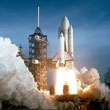 Welcome back to another exciting installment of Science Friday! I’ll be your host as we decipher the newest findings for life (or not?) on Titan, watch the sun awaken into a dangerously active phase, control your computer in a new way, and see the power of individual brain cells. All this and much more, plus our gadget of the week: The consumer-ready, realistic 3D Hologram!
Welcome back to another exciting installment of Science Friday! I’ll be your host as we decipher the newest findings for life (or not?) on Titan, watch the sun awaken into a dangerously active phase, control your computer in a new way, and see the power of individual brain cells. All this and much more, plus our gadget of the week: The consumer-ready, realistic 3D Hologram!
So, Is There Life on Titan or What?
Last week, Science Sunday brought you the story on the newest findings on Titan. Long story short: conditions consistent with the existence of life on Titan, Saturn’s large atmosphere-bearing moon, were discovered by the Cassini Spacecraft. You’ll notice that in the article we were quick to point out that the existence of life was not necessarily found. The chemical processes discovered — specifically, the lack of the organic molecule acetylene and the depletion of hydrogen close to the moon’s surface — could simply be from non-biological activity, say the mission scientists. That’s not to say this isn’t an interesting find, however, and it’s been stirring up quite a bit of news around the science community. Carolyn Porco, Cassini Imaging Team Lead, has publicly commented on the news saying that life’s involvement in the observed conditions on Titan are, “by NO means certain,” and notes that one “has to be careful when you use the word ‘life’.”
CICLOPS.org, the Cassini Imaging website, has set up a new section on the site titled, “Making Sense of the News,” where Chris McKay, NASA Ames researcher who was instrumental in recent findings, has posted comments about what was truly discovered and what was not. For even more info about the findings, see Time’s piece, “Life on Titan? Intriguing Finds on Saturn’s Moon“.

Titan may be full of surprises, but is it full of life?
As the Sun Awakens, NASA Keeps an Eye on Space Weather
NASA has described upcoming events as the meeting of the Earth and the Sun in a way that is new to human history. By this they are referring, of course, to our sun leaving a quiescent period of activity and entering a very active phase. Solar activity has been just as high in the recent past, but modern man relies much more heavily on technologies that may be crippled by something like – oh, let’s say, a solar flare – taking out the power grid. Much of the damage that can be done to electrical systems can be avoided if it is known that a solar storm is coming. That is why NASA is gearing up their monitoring of space weather. “Space weather forecasting is still in its infancy, but we’re making rapid progress,” says Thomas Bogdan, director of NOAA’s Space Weather Prediction Center. Bogdan sees the collaboration between NASA and NOAA as key. “NASA’s fleet of heliophysics research spacecraft provides us with up-to-the-minute information about what’s happening on the sun.” The video below is a fantastic explanation of the work of the NASA Heliophysics Program and why it is important.
Control Your Computer Minority Report Style, With Hand Gestures
In the future, wearing a multi-colored Day-Glo glove could bring Minority Report-style computing to your home PC. Researchers are working on technology that could do much more than use hand gestures as a fancy mouse, however. Computers are being programmed to recognize such a wide variety of hand gestures that computers could translate sign language, or allow a user to virtually assemble machinery, just for one example. The video below from NewScientist shows how impressive this technology really is.
Individual Brain Cells Can ID Cars, and Dogs
Researchers at MIT have shown that, when put to the test, individual brain cells can recognize and identify objects as different as cars and dogs. Scientists are not sure exactly how specialized brain cells are. There is a question of whether or not a brain cell must be specialized for a specific task, thought, or memory, or it some cells can be neurological generalists. Previous studies found that some brain cells could become attached to the idea of specific things such as “cat” or “dog”. In this study, researchers recorded activity in the brain as they switched back and forth between distinguishing cats vs. dogs and sports cars vs. sedans. Although they found individual neurons that were more attuned to car images and others to animal images, to their surprise, there were many neurons active in both categories. In fact, these “multitasking” neurons were best at making correct identifications in both categories.

Multitasking brain cells are better at correct IDs
Picture of the Week: Final Flight of Atlantis
+ Get Your Face Into Space
This photograph, taken of Space Shuttle Atlantis during its final launch with an F-15E Strike Eagle in the foreground, is quite possibly one of the most amazing images ever captured. Click to embiggen.

Via DISCOVER
And speaking of final shuttle missions, NASA is offering you an opportunity to put your face into space on one of the final two shuttle missions. Just go to faceinspace.nasa.gov and upload a picture or just your name, and it will be flown into space. After the flight you even get a confirmation!
Video of the Week: Symphony of Science – ‘The Case for Mars’ (ft. Zubrin, Sagan, Cox & Boston)
Yet another great installment from Symphony of Science. This time, it’s about the exploration of Mars, the red planet.
Gadget of the Week: Consumer-ready Realistic 3D Hologram
Everyone is waiting and wishing for the day where we will have those holograms we always see on sci-fi movies. A new product, the HoloAD Diamond Series, promises to deliver that wish with a fully 3D holographic display that is consumer ready. It is basically a crude example of a fully holographic TV, using three displays and strategically placed reflective glass panes to give a multi-perspective look at various objects. This sure beats those still 3D images we’ve seen in the past. And, the company says this product is no prototype — it’s ready to ship! No word yet on what this thing’ll cost you, though. Check out the video below to see it in action. (via DVICE)
#FollowFriday
If you are on Twitter, you know there are plenty of amazing people out there tweeting away. And, many of them are scientists! Every Friday I’ll be bringing you a new list of great scientists, techies, and trekkies to follow on Twitter. This week…
- @carolynporco: Planetary scientist, leader of Cassini imaging team, director of CICLOPS, & author-to-be (Not to mention, Science advisor for Star Trek 2009)
- @NASAJPL: NASA Jet Propulsion Laboratory manages many of NASA’s robotic missions exploring Earth, the solar system and our universe. Tweets from JPL’s News Office.
- @Astro_Jose: NASA Astronaut Jose Hernandez
Science Quickies
Not enough science for you? Here’s a warp-speed look at some more science tid-bits that are worth a look.
- The science of Star Trek: How close are we?
- Amazing ‘pulse of darkness‘ ray tech birthed in US gov labs
- What does the hottest matter ever made sound like?
TrekMovie’s Science Friday is an homage the the great NPR radio show Science Friday. Science Friday® is a registered service mark of ScienceFriday Inc.

Maybe we could just find alien life somewhere else…
Can see giant 3D screens like that over road intersections in major cities!
I really like these Science Posts; Thanks Kayla!
That doggy is soooo cute!
“Intercraft open.” – “Records shows the Talos group has never been explored.” When Gary Mitchel from “Where no man…” used a hand gesture to open the intercraft and Spock from “The Cage” to change the display on his screen.
Science fact is catching up with science fiction. Just have to wait for warp drive and transporters now.
Wait, are they only taking the funniest pictures into space, or do we all get a shot?
I just sent them one of me with my astronaut toy.
@4 Ummmm, the theremin was around in 1920’s and since, and only uses hand movements. Star Trek was only 40 years *behind* that curve!
Sounds like we need to get Sean (Jeffrey) Christopher from the preceding article up to Saturn lickety-split to settle this “life on Titan” question.
And was anyone as puzzled by the dark pulse ray article as I was? Not so much the explanation of how it works, but such stuff as , “The boffins of the US National Institute of Standards and Technology, who unlocked the secrets of darkness, are chuffed as ninepence with their new kit. ” :-D
Scott B. out.
P.S. Great pic of the shuttle launch.
@4
I believe the hand gesture Spock uses, is directed at a female crewmember off screen– to change the diplay for him.
* throws an “s” up in diplay*
diplay=display
There can’t be any life on Titan or Chekov wouldn’t have suggested they just randomly drop into the atmosphere out of warp.
Unless of course that life had already packed up and moved….
If we don’t find life elsewhere in the solar system, why don’t we shoot compost at Mars, Titan, Europa, etc. and see what happens?
That is an awsome shot of Titan! and that picture of the shuttle launch deserves to be framed!
The hand/movement/control thing is way too cool…i can’t wait to see where they go with improvements and developement…
The mars video is a bit nerdy, but its funny how they can turn ordinary speaking into (kind of ) singing (i guess you could say).
The holoAD stuff just made me say holy crap. thats is just amazing.
You rock, Kayla! Keep up the good work!
Love the Chris McKay!
I interviewed this guy when I was 16 years old on terraforming Mars usinf CFCs!
“Click to Embiggen” – love the Simpsons reference! Thanks for another awesome Science Friday!
#12 kind of ordinary speaking turned into singing?. Shats been doing that forever. lol
Interesting stuff here. As ever. Thanks. I love Trekmovie!
#8- That Spock hand gesture always looks so badass.
That holo-display is awesome. We’ll have them everywhere sooner than we think.
Awesome shuttle pic!!!!!!!!!!!!!
# 17
I concur. It is friggin’ sweet!
That holo-display needed two other images: Anne Francis and Michael York
#14 – It’s a perfectly cromulent word!